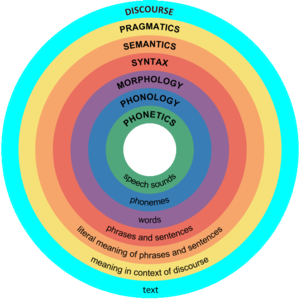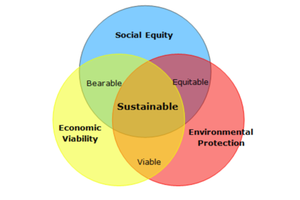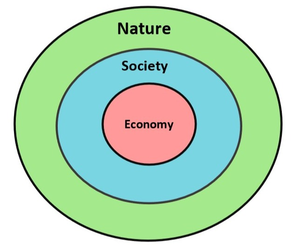Linguistics and sustainability

Linguistics is the scientific study of language (spoken, signed, written, etc.) and the structures of these forms of communication employ. Linguists, experts in linguistics, are interested in understanding how language(s) work(s). To do this, linguists can study a single or multiple languages to further develop the understanding of language in general and to understand traits/properties that are common to all languages or groups of languages.[1]
Sustainability, in the broadest sense, refers to the ability to maintain or support systems or processes in a way that allows continuity over time. Traditionally, when referring to sustainability, one considers the economic, social and environmental pillars that make up the pillars of sustainability. In their book "Situating Sustainability" Reetta Toivainen and Parker Krieg[2] refer to sustainability as "harm reduction."

Linguistics and sustainability overlap to the proposed subfield known as sustainable linguistics. The relationship between sustainability and linguistics is intricate involving several lenses that the relationship can be approached from which are expanded on through these wiki pages. Linguistics is the scientific study of languages and their structures, including the sounds, words, and grammar used in communication. Meanwhile, sustainability is the idea of "meeting the needs of the present without compromising the ability of future generations to meet their own needs"[4].
These topics overlap into disciplines such as ecolinguistics, the study of the relationship between language and the environment. This discipline can also include the sustainability of linguistic practices, referring to, for example, the practices that linguists employ to obtain consultants, elicit information, the relationship between the researcher and the community/people they work with, and the genuine effort of the researcher to ensure their research benefits the community and not solely the linguist themself. Linguistic sustainability is another term used in understanding of the overlap between language and sustainability and refers to the maintenance of linguistic diversity in simple terms. Each of these terms can be employed differently by different persons.
The hierarchy of authentic sustainability
"With the worldview of “authentic sustainability,” as depicted in the graphic, there is no area or subset of economic activities that is isolated or separate from society. There is no area or subset of societal activities that is separate or isolated from nature. The worldview of authentic sustainability is also an interconnected, ecological view of the world. Since society is an integral part of nature, every human activity within society is also an act of nature, and thus has a direct positive or negative impact on nature. Since the economy is an integral part of society and of nature, every economic act has a direct positive or negative impact on society and nature."[5]
As aspects of human life, language and human well-being are both part of society. Looking at the image, environment in its narrow definition ("nature") contains all of society. Environment, if used in the ecological context, may also mean a broader living place where society is an environment for language. A broader well-being would then include the well-being of all levels; nature, society, and economy.
References[edit | edit source]
- ↑ 1.0 1.1 https://blogonlinguistics.wordpress.com/2016/03/26/what-is-linguistics/
- ↑ Krieg, C. Parker, and Reetta Toivanen. 2021. Situating Sustainability: A Handbook of Contexts and Concepts. Helsinki: Helsinki University Press. DOI: https://doi.org/10.33134/HUP-14
- ↑ https://www.futurelearn.com/info/courses/sustainability-society-and-you/0/steps/4618
- ↑ https://www.un.org/en/academic-impact/sustainability
- ↑ https://www.johnikerd.com/post/the-hierarchy-of-authentic-sustainability
